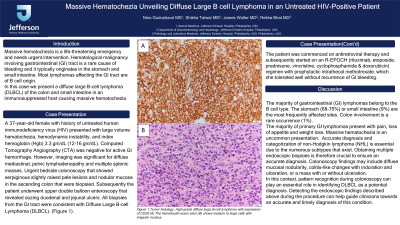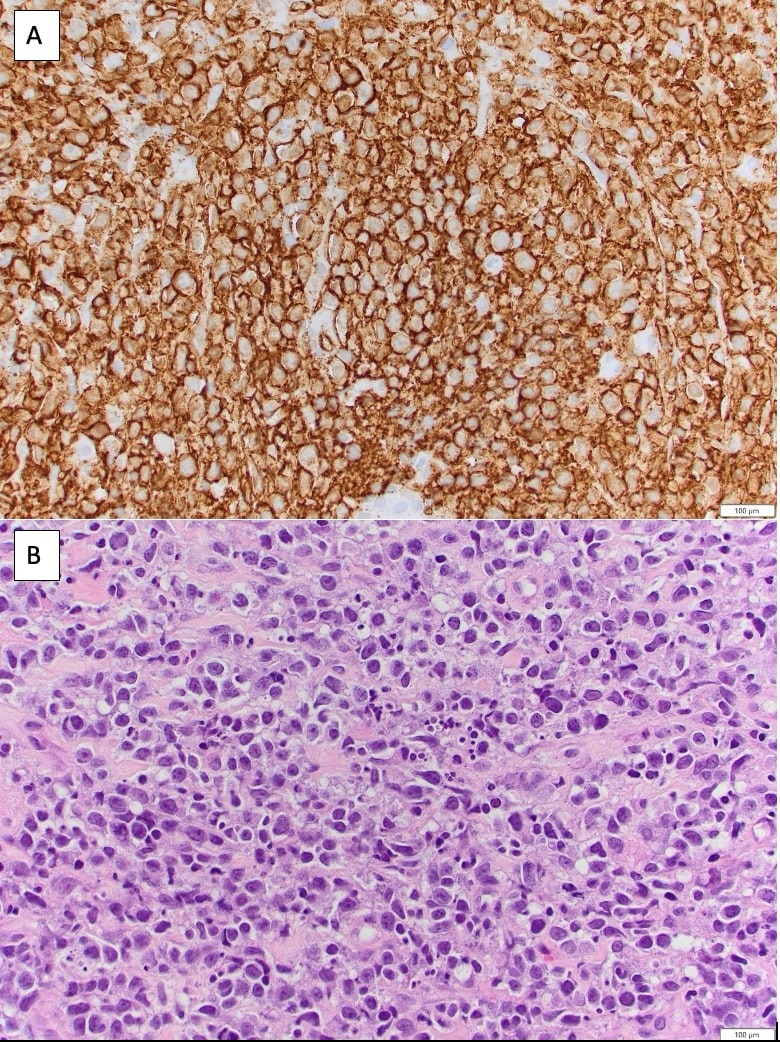Monday Poster Session
Category: GI Bleeding
P2491 - Massive Hematochezia Unveiling Diffuse Large B-Cell Lymphoma in an Untreated HIV-Positive Patient
Monday, October 28, 2024
10:30 AM - 4:00 PM ET
Location: Exhibit Hall E

Has Audio

Nino Gudushauri, MD
Jefferson Einstein Hospital
Philadelphia, PA
Presenting Author(s)
Nino Gudushauri, MD1, Shikha Talwar, MD2, James Walter, MD3, Rekha Bhat, MD4
1Jefferson Einstein Hospital, Philadelphia, PA; 2Jefferson Einstein, Philadelphia, PA; 3Einstein Healthcare Network, Philadelphia, PA; 4Albert Einstein Medical Center, Philadelphia, PA
Introduction: Massive hematochezia is a life-threatening emergency and needs urgent intervention. Hematological malignancy involving gastrointestinal (GI) tract is a rare cause of bleeding and it typically originates in the stomach and small intestine. The majority of lymphomas affecting the GI tract are of B cell origin. We present a diffuse large B-cell lymphoma (DLBCL) of the colon and small intestine in an immunosuppressed host causing massive hematochezia.
Case Description/Methods: A 37-year-old female with history of untreated human immunodeficiency virus (HIV) presented with large volume hematochezia, hemodynamic instability, and index hemoglobin (Hgb) 3.3 gm/dL(12-16 gm/dL). Computed Tomography Angiography was negative for active GI hemorrhage. However, imaging was significant for diffuse mediastinal, pelvic lymphadenopathy and multiple splenic masses. Urgent bedside colonoscopy showed serpiginous slightly raised pale lesions and nodular mucosa in the ascending colon that were biopsied. Subsequently the patient underwent upper double balloon enteroscopy that revealed oozing duodenal and jejunal ulcers. All biopsies from the GI tract were consistent with Diffuse Large B-cell Lymphoma (DLBCL).
The patient was commenced on antiretroviral therapy and subsequently started on R-EPOCH (rituximab, etoposide, prednisone, vincristine, cyclophosphamide & doxorubicin) regimen with prophylactic intrathecal methotrexate that she tolerated well without recurrence of GI bleeding.
Discussion: The majority of gastrointestinal (GI) lymphomas belong to the B cell type.The stomach (68-75%) or small intestine (9%) are the most frequently affected sites. Colon involvement is a rare occurrence (1%).The majority of primary GI lymphomas present with pain, loss of appetite and weight loss. Massive hematochezia is an uncommon presentation. Accurate diagnosis and categorization of non-Hodgkin lymphoma is essential due to the numerous subtypes that exist. Obtaining multiple endoscopic biopsies is therefore crucial to ensure an accurate diagnosis. Colonoscopic findings may include diffuse mucosal nodularity, colitis-like changes with induration and ulceration, or a mass with or without ulceration.
In this context, pattern recognition during colonoscopy can play an essential role in identifying DLBCL as a potential diagnosis. Detecting the endoscopic findings described above during the procedure can help guide clinicians towards an accurate and timely diagnosis of this condition.

Disclosures:
Nino Gudushauri, MD1, Shikha Talwar, MD2, James Walter, MD3, Rekha Bhat, MD4. P2491 - Massive Hematochezia Unveiling Diffuse Large B-Cell Lymphoma in an Untreated HIV-Positive Patient, ACG 2024 Annual Scientific Meeting Abstracts. Philadelphia, PA: American College of Gastroenterology.
1Jefferson Einstein Hospital, Philadelphia, PA; 2Jefferson Einstein, Philadelphia, PA; 3Einstein Healthcare Network, Philadelphia, PA; 4Albert Einstein Medical Center, Philadelphia, PA
Introduction: Massive hematochezia is a life-threatening emergency and needs urgent intervention. Hematological malignancy involving gastrointestinal (GI) tract is a rare cause of bleeding and it typically originates in the stomach and small intestine. The majority of lymphomas affecting the GI tract are of B cell origin. We present a diffuse large B-cell lymphoma (DLBCL) of the colon and small intestine in an immunosuppressed host causing massive hematochezia.
Case Description/Methods: A 37-year-old female with history of untreated human immunodeficiency virus (HIV) presented with large volume hematochezia, hemodynamic instability, and index hemoglobin (Hgb) 3.3 gm/dL(12-16 gm/dL). Computed Tomography Angiography was negative for active GI hemorrhage. However, imaging was significant for diffuse mediastinal, pelvic lymphadenopathy and multiple splenic masses. Urgent bedside colonoscopy showed serpiginous slightly raised pale lesions and nodular mucosa in the ascending colon that were biopsied. Subsequently the patient underwent upper double balloon enteroscopy that revealed oozing duodenal and jejunal ulcers. All biopsies from the GI tract were consistent with Diffuse Large B-cell Lymphoma (DLBCL).
The patient was commenced on antiretroviral therapy and subsequently started on R-EPOCH (rituximab, etoposide, prednisone, vincristine, cyclophosphamide & doxorubicin) regimen with prophylactic intrathecal methotrexate that she tolerated well without recurrence of GI bleeding.
Discussion: The majority of gastrointestinal (GI) lymphomas belong to the B cell type.The stomach (68-75%) or small intestine (9%) are the most frequently affected sites. Colon involvement is a rare occurrence (1%).The majority of primary GI lymphomas present with pain, loss of appetite and weight loss. Massive hematochezia is an uncommon presentation. Accurate diagnosis and categorization of non-Hodgkin lymphoma is essential due to the numerous subtypes that exist. Obtaining multiple endoscopic biopsies is therefore crucial to ensure an accurate diagnosis. Colonoscopic findings may include diffuse mucosal nodularity, colitis-like changes with induration and ulceration, or a mass with or without ulceration.
In this context, pattern recognition during colonoscopy can play an essential role in identifying DLBCL as a potential diagnosis. Detecting the endoscopic findings described above during the procedure can help guide clinicians towards an accurate and timely diagnosis of this condition.

Figure: Tumor histology. High-grade diffuse large B-cell lymphoma with expression of CD20 (A).The hematoxylin-eosin stain (B) shows medium to large cells with irregular nucleus.
Disclosures:
Nino Gudushauri indicated no relevant financial relationships.
Shikha Talwar indicated no relevant financial relationships.
James Walter: Eli Lilly – Advisor or Review Panel Member. Medtronic – Consultant.
Rekha Bhat indicated no relevant financial relationships.
Nino Gudushauri, MD1, Shikha Talwar, MD2, James Walter, MD3, Rekha Bhat, MD4. P2491 - Massive Hematochezia Unveiling Diffuse Large B-Cell Lymphoma in an Untreated HIV-Positive Patient, ACG 2024 Annual Scientific Meeting Abstracts. Philadelphia, PA: American College of Gastroenterology.
